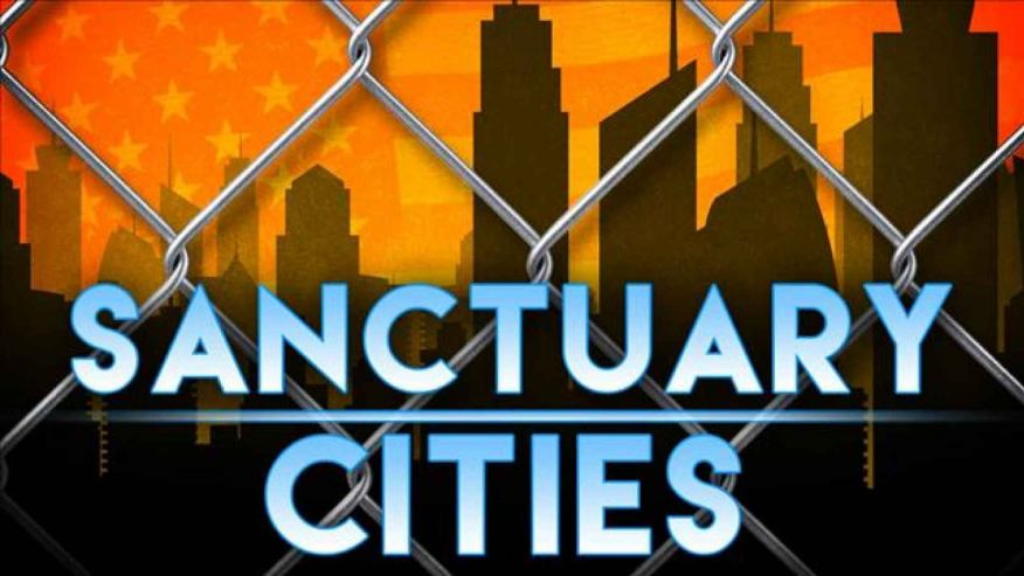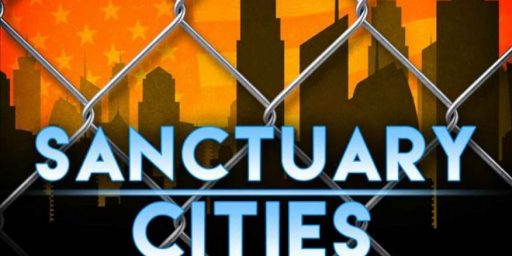Federal Appeals Court: Trump’s Crackdown On Sanctuary Cities Unconstitutional
A Federal Appeals Court has found that a Trump Administration policy purporting to punish so-called sanctuary cities is unconstitutional.

A three-judge panel of the Ninth Circuit Court of Appeals has ruled that a Trump Administration order seeking to punish so-called “sanctuary cities” by withholding funding is unconstitutional:
A federal appeals court in California ruled Wednesday that President Trump acted beyond his authority when issuing an executive order attempting to penalize “sanctuary cities” for refusing to cooperate with the administration’s immigration crackdown.
The decision, issued by the U.S. Court of Appeals for the 9th Circuit, barred the Trump administration from defunding San Francisco and Santa Clara County, the case’s two plaintiffs, but it did not uphold a nationwide injunction issued late last year by U.S. District Court Judge William H. Orrick of the Northern District of California. Instead, by a vote of 2 to 1, the three-judge panel sent the case back to the district court for additional fact-finding on the order’s nationwide impact.
Cities and states across the country had varying responses to Trump’s executive order, which he signed in January 2017. Some initiated lawsuits and others introduced noncooperation legislation.
California, which has clashed with the administration repeatedly over efforts to curtail legal and illegal immigration, refused to comply with Trump’s order. In response, the Justice Department filed a lawsuit against California in March. Three state laws, according to Attorney General Jeff Sessions, “intentionally obstruct and discriminate against the enforcement of federal immigration law,” impeding U.S. Immigration and Customs Enforcement from deporting noncitizens.
“Today’s divided Ninth Circuit opinion is a victory for criminal aliens in California, who can continue to commit crimes knowing that the state’s leadership will protect them from federal immigration officers whose job it is to hold them accountable and remove them from the country,” Justice Department spokesman Devin O’Malley said in a statement. “The Justice Department continues to maintain that — as the dissenting judge recognized — the President exercised his lawful authority when he issued the sanctuary city Executive Order.”
More from The San Francisco Chronicle:
President Trump abused his authority by ordering the denial of federal funds to San Francisco and other sanctuary cities for refusing to cooperate with immigration officers, a federal appeals court ruled Wednesday.
In a 2-1 decision, the Ninth U.S. Circuit Court of Appeals in San Francisco said Trump acted unconstitutionally in an executive order he issued in January 2017, five days after taking office, declaring that local governments that refused to provide information or access to federal immigration agents would be ineligible for federal grants. Federal courts since then have refused to enforce the order or other administration efforts to withhold funding from sanctuary cities.
“The United States Constitution exclusively grants the power of the purse to Congress, not the president,” Chief Judge Sidney Thomas said in the majority opinion. Because Congress has not passed a law authorizing the president to deny funding to sanctuary cities — and, in fact, rejected such legislation even during President Barack Obama’s administration — Trump’s order “violates the constitutional principle of the separation of powers,” Thomas said.
The appeals court upheld an injunction by U.S. District Judge William Orrick of San Francisco in November that prohibited Trump from withholding federal grants from San Francisco and Santa Clara County, which jointly sued to challenge the executive order. Both counties receive more than $1 billion a year in federal funds and said they would be severely harmed by a cutoff.
The court rejected provisions of the injunction that barred funding cutoffs to any of the hundreds of sanctuary cities across the country. Thomas said the court lacked evidence on the potential impact of the cuts in other states, and told Orrick to reconsider the scope of his order.
However, federal judges in other states have issued similar injunctions prohibiting cutoffs of federal funding. Additionally, a federal judge in Sacramento has rejected the Trump administration’s challenge to a “sanctuary state” law that restricted the authority of law enforcement agencies in California to share information with immigration officers.
And federal courts in San Francisco and elsewhere have not been receptive to Attorney General Jeff Sessions’ attempt to craft a narrower order that would deny specific grants to cities and counties that refused to notify immigration agents of the impending release of undocumented immigrants in local custody.
In defense of Trump’s order, Justice Department lawyers argued that the president never sought to cut off all federal funding to sanctuary cities, but simply directed Sessions to enforce existing laws. One such law requires state and local governments to allow police to share information with federal officers about the immigration status of anyone in local custody.
San Francisco officials say the city provides immigration-status information when the government asks for it, but refuses to go further by notifying federal agents of immigrants’ scheduled release dates, or obeying federal detainers to keep inmates in custody beyond their release dates so that immigration agents can pick them up. Sessions contends federal law requires local governments to comply with detainers, but the courts so far have not agreed.
Dissenting from Wednesday’s ruling, Judge Ferdinand Fernandez said Trump had merely directed his subordinates “to see that duly adopted laws were faithfully executed.” Fernandez accused Orrick and the appeals court majority of rewriting Trump’s order and then choosing to “take up arms to vanquish the imagined beast.”
But Thomas, joined by Judge Ronald Gould, said Trump had made his intentions clear in the language of his order, which declared that cities and counties refusing to comply with immigration law, as the administration interpreted it, were “not eligible to receive federal grants,” except those the administration considered necessary for law enforcement purposes.
Thomas also cited a White House press release that said Trump had issued an order “halting federal funding for sanctuary cities.”
As noted above, this ruling from the Ninth Circuit is the latest in a series of rulings from Federal Courts across the country that have found various efforts by the Trump Administration to punish localities for refusing to comply with Federal policies regarding undocumented immigrants to be unconstitutional. Among the first of those rulings came from Federal District Court Judge William Orrick, who struck down one of those Trump Administration policies in a ruling issued in April of last year that ruling was repeated again in a final ruling in late 2017. This is the ruling that was ultimately appealed to the Ninth Circuit and largely upheld by the three-judge panel. Several months later, another Federal Judge in Illinois, ruling in a case that had been filed by the City of Chicago, issued a ruling that was largely identical to that issued by Judge Orrick. That ruling was subsequently upheld by the three-judge panel of the Seventh Circuit Court of Appeals. More recently, a Federal Judge in Pennsylvania ruled that the Trump Administration policy was unconstitutional and a Federal Judge in Sacramento largely rejected a Justice Department challenge to a series of new California laws that seek to protect the sanctuary city policies of the state’s localities by enshrining them in state law.
The panel did hand the Federal Government a small victory of sorts in that it declined to adopt the nationwide injunction that Judge Orrick had issued in his ruling in the case. As the majority opinion notes, this was mostly because the record in the case was not sufficient evidence regarding the impact of Trump policy outside of the Plaintiff jurisdictions in the record that had presented on appeal. Ultimately, though this is something of a pyrrhic victory in that each of the other injunctions noted above, including the ruling from the Seventh Circuit in the lawsuit that had been filed by the City of Chicago, state by their terms that they apply nationwide. As a result, the decision of the panel here to decline to give their ruling effect beyond the parties that had brought the initial lawsuit does not really have any practical impact on the Trump Administration’s policy which remains blocked nationwide by virtue of the other injunctions that have been entered against its enforcement.
In this case, as in each of the cases where the Trump Administration policies have been struck down, the Ninth Circuit found that the policy was impermissible on both statutory and Constitutional grounds. On the statutory side of the ledger, the court found, as previous courts have found, that the policy exceeded the authority granted to the Executive Branch by statute. Additionally, the court found that the policy exceeded the authority granted to the Federal Government to compel states and localities to act based largely on the Tenth Amendment and other provisions of the Constitution. As a general rule, the extent to which the Federal government can compel states to comply with the Federal law has been shaped, and limited, by a series of cases that stretch back more than thirty years. These cases include the 1987 Supreme Court ruling called South Dakota v. Dole and a series of cases that followed that ruling as I’ve explained in the past:
The Supreme Court has dealt with this issue most recently in a series of cases that go back more than twenty years, starting with South Dakota v. Dole in 1987, and continuing into the 1990s with New York v. United States and Printz v. United States.
In Dole, the Court dealt with a challenge by South Dakota and other states challenging a Federal law that withheld 5% of allocated Federal highway funds from states that declined to raise their drinking age, arguing that the statute was not a valid use of Congressional authority that interfered with state powers reserved by the Tenth Amendment. The Court ruled in favor of the Federal Government but also set forth a series of criteria that the Federal Government must meet in order to avoid violating the Tenth Amendment and other protections of the rights and powers of the states when using this method to force action by the states. New York v. United States, which was decided about five years after Dole, dealt with a Federal law governing the disposal of low levels of radioactive waste. One of the provisions of that law required states to “take title” to such waste and made them primarily responsible for its disposal, a provision which the Court found to be beyond the boundaries of both the Commerce Clause and the Tenth Amendment. Finally, about five years after New York, the Court issued a ruling in Printz v. United Statesthat has stood for twenty years as the definitive ruling on the extent to which Federal law can be used to compel states to act. Printz dealt with provisions of the Brady Handgun Violence Prevention Act, the so-called “Brady Bill.” One part of that bill required state and local law enforcement to conduct background checks for all gun purchases within their borders for an interim period until a Federal database that would conduct those checks on a more-or-less instant basis could be built, tested, and put into operation. The Supreme Court struck that provision down as unconstitutional under the Tenth Amendment in a decision written by Justice Scalia that relied heavily on both the criteria set forth in Dole for the criteria the Federal Government must meet to compel state’s to perform certain acts or pass certain laws and the holding in New York that more fully developed the limits on the Federal Government’s ability to force the states to act. One other decision, which Judge Orrick cites in his opinion is National Federation of Independent Business v. Sebelius, the 2011 case in which the Supreme Court largely upheld the Constitutional arguments against the Affordable Care Act. In one part of that decision, though, the Court struck down one provision of the PPACA that purported to use Federal power to force the states to expand Medicaid by threatening to withhold all of a state’s Medicaid funding if it declined to expand coverage as permitted under the PPACA. While there was not a solid majority supporting the reasoning for a decision in that part of the case, there was a majority in agreement with the result that the requirement that states expand the program or risk losing hundreds of millions of dollars or more in Medcaid funding was not permissible under either Article I or the Tenth Amendment.
What these cases stand for generally is the idea that, while there are some circumstances in which the Federal Government can use the power of the purse to compel state action in a given policy area, those areas are limited and there must be some conceivable nexus between the “punishment” being enacted by the Federal government for failure to comply and the policy that the Federal government is trying to force the states to adopt. In this cases and the others like it, the Courts have invariably found that the nexus here simply does not exist and that the Federal Government cannot withhold funding generally available to states and localities to do anything the Federal Government wants. This is especially true in an area such as this where local law enforcement is under no legal obligation to enforce Federal immigration laws,
As a matter of policy, the states and localities challenging the Trump Administrations actions regarding sanctuary cities have argued that acting in compliance with the President’s order would have a series of negative impacts on their own ability to govern themselves and perform vital municipal and state functions. This is especially true in the area of law enforcement. For example, it’s quite common for police to find that immigrants, legal or not, are often reluctant to report crimes committed against them to the police or to cooperate or come forward as witnesses to a crime out of the fear that doing so could subject them to being handed over to Immigration and Customs Enforcement authorities and, ultimately, subject to deportation proceedings. Operating on a policy that local authorities will not turn such people over to ICE aids law enforcement, they argue, because it helps to belay that fear among members of an immigrant community in their jurisdiction and allows law enforcement to fight crime. This is especially true among undocumented immigrants since this group tends to be a common target of criminals in their own communities if they believe that their actions will go unreported or that witnesses will remain silent even if they do know something about a criminal act in their area. Without such a policy, the localities have argued, police will have a hard time doing their jobs and the immigrant community becomes even more of a criminal target. This strikes me as fairly good reasoning, and the Federal efforts to enforce compliance and state action seem contradictory to a desire to lower crime rates nationwide.
Where the case decided by the Ninth Circuit goes from here is largely dependant on what the Federal Government decides to do. One option would be to seek an en banc review of the ruling by the full Ninth Circuit, but this type of review is rarely granted and, given the composition of the Ninth Circuit as a whole, it seems unlikely that the full Court would rule differently from this panel. The next option, of course, would be to seek Supreme Court review of the ruling at some point in the term that begins in October, but it’s unclear if the Court would be willing to accept the case for review. Finally, of course, the Administration could decide to not appeal the case at all, but that seems unlikely under the circumstances. Whether it ends up being this case or another one, this seems as if it will be an issue that the Supreme Court will ultimately have to deal with some time in the next year or so. How that turns out is anyone’s guess at this point.
Here’s the opinion:
San Francisco v. Trump Et Al by Doug Mataconis on Scribd





Debates in the Federal Convention of 1787
Monday August, 27
by James Madison
On the question for agreeing to Mr. DICKINSON’S motion, it was negatived, — Connecticut, aye; all the other States present, no.
Mr. DICKINSON’S MOTION